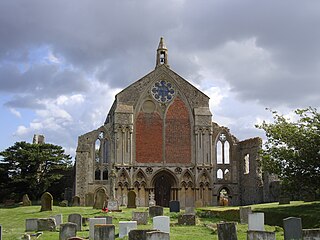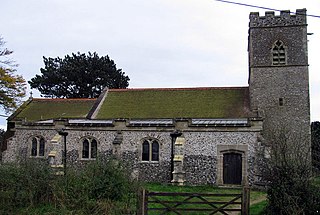

Aldeby Priory was a 12th-century Benedictine monastic house in Aldeby, Norfolk, England.


Aldeby Priory was a 12th-century Benedictine monastic house in Aldeby, Norfolk, England.
Agnes de Beaupré, who was afterwards the wife of Hubert de Rye, gave in the reign of Henry I, the church and manor of Aldeby to the monks of Norwich. [1] [2] Whereupon Bishop Herbert placed here a prior and three Benedictine monks, establishing the house as a priory cell of Norwich. When the conventual church was founded, Bishop Herbert laid the first foundation-stone and Hubert and Agnes the second. Henry I confirmed to the priory, which was dedicated to the honour of St. Mary, the grant by Hubert de Rye of tithes in Swanton, [3] Hockering, and Deepham, together with the church and manor of Aldeby, and other grants of Henry de Rye, the son of Hubert. The temporalities were valued at £71 5s. 6d. in the year 1428. [1]
In 1275 the jury of Knavering hundred found the prior of Aldeby had assize of bread and beer, and held view of frank-pledge, but they knew not by what warrant. In 1286 William Rosalyne purchased of the prior and convent of Norwich the lordship of this town, except certain messuages and lands and the advowson of the church, which were reserved to the convent and henceforth called the prior's manor. [1]
On 27 May 1355, John de Bedingfield, prior of Aldeby, was appointed by Laurence, prior of Norwich, acting as vicar-general for the bishop, to hear the confessions of the nuns of Bungay. In 1376 Sir Thomas Savage was buried by the south porch of the priory church. [1] In 1466 Lady Isabel Morley died patroness of the priory, being heir to the founders, Hubert and Agnes de Rye. In 1481 Edmund Salle, Roger Framlingham, and William Spink were the three monks of this cell.
The priors of the several cells of Norwich had to present annual accounts to the prior of Norwich. Various of these account rolls for Aldeby are extant in the treasury of Norwich Cathedral, namely from 1422 to 1426, from 1440 to 1442, for the year 1462, and twelve others at irregular intervals, the last being for 1523. [1]
At the visitation of Norwich Priory in 1514, John Lakenham, the prior of Aldeby, could only give a poor account of himself and his cell. He had not handed in the accounts of the last year, though he said he was prepared to do so; the house was in debt to the extent of £10; he had only paid £5 of his annual pension to the mother house, but the cellarer held a marsh pertaining to the cell by way of exoneration; the gates of the cell and the brewery were in a ruinous state. The bishop's injunctions consequent on this visit insist on all cells returning annual accounts to be deposited in the Norwich treasury each Michaelmas. Edmund Norwich was prior of Aldeby at the visitation of 1532; he was examined, but only as to the condition of Norwich Priory. [1]
(Merge: /copyedit) At Aldby, Aldeby, or Aldeburg, was a small priory, or a cell, to that of Norwich. It was founded by Agnes de Beaufoe, or Beko, afterwards wife of Hubert de Rye, for a prior and three black monks; and was endowed with lands and appropriate tythes, in the time of Henry the First, by Henry de Rye, the son of Hubert and Agnes, " whom Tanner, by mistake, calls Robert de Ria*." [4] From a licence granted by King Edward the First, to William Roscelyne, for purchasing of the priory at Norwich, the lordship of this village, except a manor reserved to the convent; it appears, contrary to the opinion of some great lawyers, that manors have been erected within what is termed prescriptive time. Other instances will occur corroborative of this fact. In a contest, subsequent to this purchase, between William Rospelyne and the prior, respecting commonable rights; the former permitted the latter to dig marie, for the purpose of improving his lands in the great common of Aldby, then called Mekylheyth. [4] This was in the year 1310, and the circumstance tends to prove, that what is magnified into new discovery, is often no more than a renewal of an old practice, which had been long neglected, or forgotten. Marling of lands, in which beneficial improvement Norfolk has eminently taken the lead, is stated, by some authors on agriculture, to have been first introduced about the year 1748. The temporalities of this priory, in the sixth year of Edward the Fourth, were valued at 7l. 15s. 6d. On the dissolution it escheated to the crown, and, on the foundation of a dean and chapter at Norwich, was conferred on that ecclesiastical body. [4]

St Benet's Abbey was a medieval monastery of the Order of Saint Benedict, also known as St Benet's at Holme or Hulme. It was situated at Cow Holm, Horning, on the River Bure within the Broads in Norfolk, England. St Benet is a medieval English version of the name of St Benedict of Nursia, hailed as the founder of western monasticism. At the period of the Dissolution of the Monasteries the abbey's possessions were in effect seized by the crown and assigned to the diocese of Norwich. Though the monastery was supposed to continue as a community, within a few years at least the monks had dispersed. Today there remain only ruins.

Alien priories were religious establishments in England, such as monasteries and convents, which were under the control of another religious house outside England. Usually the mother-house was in France.

Thetford Priory is a Cluniac monastic house in Thetford, Norfolk, England. Founded in 1103 by Roger Bigod of Norfolk, Thetford was one of the most important monasteries of East Anglia.

St Mary's Priory, Binham, or Binham Priory, is a ruined Benedictine priory located in the village of Binham in the English county of Norfolk. Today the nave of the much larger priory church has become the Church of St. Mary and the Holy Cross and is still used as a place of worship. The remains of the priory are in the care of English Heritage. The abbey's west face is the first example in England of gothic bar tracery, predating Westminster Abbey by a decade.

St John's Abbey, also called Colchester Abbey, was a Benedictine monastic institution in Colchester, Essex, founded in 1095. It was dissolved in 1539. Most of the abbey buildings were subsequently demolished to construct a large private house on the site, which was itself destroyed in fighting during the 1648 siege of Colchester. The only substantial remnant is the elaborate gatehouse, while the foundations of the abbey church were only rediscovered in 2010.
Colne Priory at Earls Colne, Essex was a Benedictine priory, initially a dependent cell of Abingdon Abbey, Berkshire. It was founded by Aubrey de Vere I and his wife Beatrice in or before 1111. One piece of research suggests that the original Abbot, Faritius, was appointed in 1101; he initially placed six monks at the site. Their eldest son Geoffrey had died at Abingdon about seven or eight years earlier and was buried there. On his deathbed, Geoffrey had bequeathed to Abingdon the church and lands at Kensington, Middlesex, and his parents and brothers had confirmed that grant, as had King Henry I.
Alan fitz Flaad was a Breton knight, probably recruited as a mercenary by Henry I of England in his conflicts with his brothers. After Henry became King of England, Alan became an assiduous courtier and obtained large estates in Norfolk, Sussex, Shropshire, and elsewhere in the Midlands, including the feudal barony and castle of Oswestry in Shropshire. His duties included supervision of the Welsh border. He is now noted as the progenitor of the FitzAlan family, the Earls of Arundel (1267–1580), and the House of Stuart, although his family connections were long a matter of conjecture and controversy.

Hatfield Broad Oak Priory, or Hatfield Regis Priory, is a former Benedictine priory in Hatfield Broad Oak, Essex, England. Founded by 1139, it was dissolved in 1536 as part of Henry VIII's dissolution of the monasteries.

Swanton Novers is a village and a civil parish in the English county of Norfolk. The village is 15.1 miles (24.3 km) west-south-west of Cromer, 23.1 miles (37.2 km) north-north-west of Norwich and 123 kilometres (76 mi) north-north-east of London. The village lies 6 miles (9.7 km) south-west of the town of Holt. The nearest railway station is at Sheringham for the Bittern Line which runs between Sheringham, Cromer and Norwich. The nearest airport is Norwich International Airport.

Goldcliff Priory was a Benedictine monastery in Goldcliff, Newport, South Wales. It was established in 1113 by Robert de Chandos as a subsidiary house of the Abbey of Bec in Normandy. The priory was built on a coastal site, now the land of Hill Farm. In the 1950s, the Monmouthshire writer Hando noted the outlines of buildings visible as grass patterns or crop marks, but by the 1970s the only remaining structural element was part of a cellar in the farm house.

Pamber Priory is a Church of England parish church and former priory, then known as West Sherborne Priory or Monk Sherborne Priory, at Monk Sherborne in the English county of Hampshire.

Carrow Abbey is a former Benedictine priory in Bracondale, southeast Norwich, England. The village on the site used to be called Carrow and gives its name to Carrow Road, the football ground of Norwich F.C., located just metres to the north. Granted by charter of King Stephen, the abbey was founded ca. 1146, and became a Grade I listed building in 1954.

Farewell Priory was a Benedictine nunnery near Lichfield in Staffordshire, England. Although it received considerable episcopal support, it was always small and poor. It was dissolved in 1527 as a by-product of Cardinal Wolsey's scheme to establish a college within Oxford University.
Campsey Priory,, was a religious house of Augustinian canonesses at Campsea Ashe, Suffolk, about 1.5 miles (2.5 km) south east of Wickham Market. It was founded shortly before 1195 on behalf of two of his sisters by Theobald de Valoines, who, with his wife Avice, had previously founded Hickling Priory in Norfolk for male canons in 1185. Both houses were suppressed in 1536.

Monks Kirby Priory was a Benedictine priory established in 1077 in Monks Kirby, Warwickshire, England. The priory was suppressed in 1415 when its estates and revenues were given to the Carthusian priory of Axholme in Lincolnshire, in whose possession they continued until the Reformation. Remains of the priory form part of Monks Kirby village church today.
Avebury Priory was an alien house of Benedictine monks in Wiltshire, England, between the early 12th century and the Dissolution.

Morville Priory was a small Benedictine monastery in Shropshire, England, a cell of Shrewsbury Abbey.
Stoke-by-Clare Priory was a Benedictine monastery in Stoke-by-Clare, in Suffolk, an alien priory, dependent on Bec Abbey, in Normandy. Reinstituted in 1124, the Priory was suppressed in 1415.
Edith Wilton was an English prioress at Carrow Abbey in Norwich.